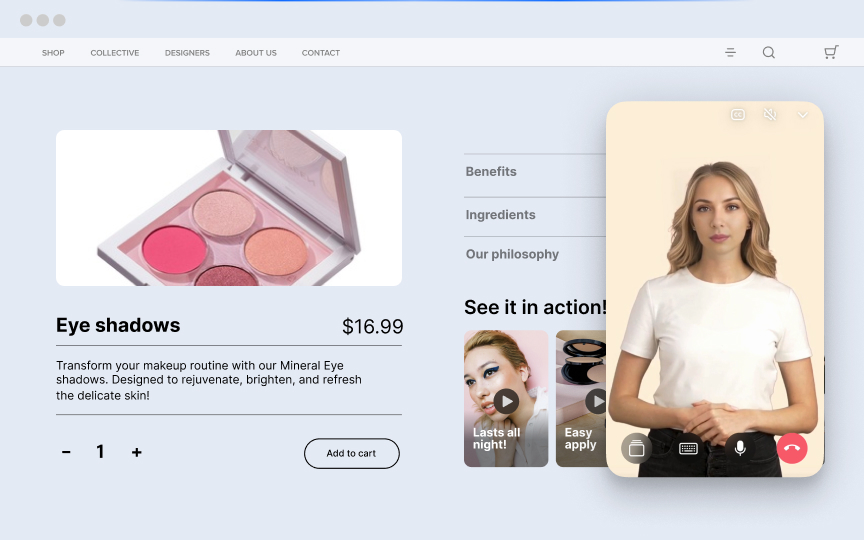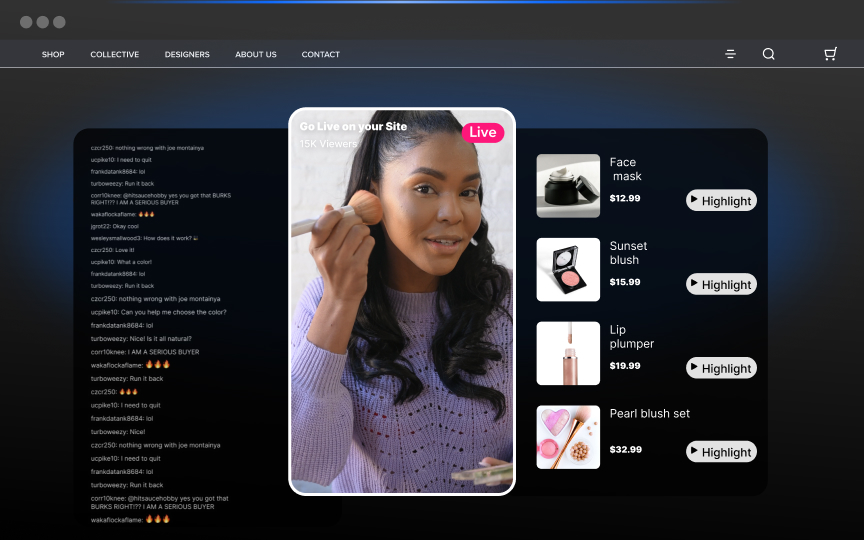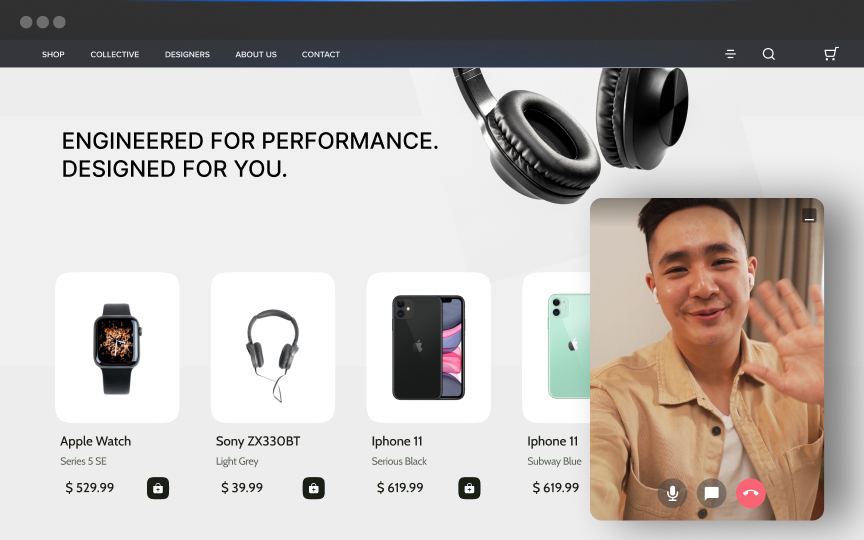There was a day when the fashion industry was associated with glitz and glam. It was about the fabric, the cut, and the style. Unfortunately, for years, tech innovation has been missing in the industry. From the introduction of the sewing machine in the 1800s to the surprise of wearable lights in fashion in the 1900s to AR-powered retail experiences in the modern day, the fashion industry has gone through tremendous but innovative transformations.
Today, the future of fashion is exciting. Fashion will become a $3 trillion sector by the end of this decade, thanks to the growing popularity of livestream shopping for fashion. But, before we talk about livestream fashion, let's get some insight into the future of the fashion world.
Fashion Industry In The Coming Years
Fashion is the most important segment of the B2C eCommerce market. The worldwide eCommerce fashion industry was pegged at $550 billion in 2020. By 2030, it is anticipated to expand at more than 13% annually and reach a total market value of over $1.9 trillion.eCommerce will fuel more than 60% of the global fashion market by the end of this decade!
Current State of the Global eCommerce Fashion Industry
The integration of livestream shopping across multiple channels and eCommerce will impact the future of fashion businesses. However, there are several challenges at hand that are hindering its online growth. Let's discuss a few:
1. Soaring Ad Prices and Customer Acquisition Costs
A recent study noted a 222% rise in customer acquisition costs (from losing $9 per customer in 2013 to $29 per customer in 2022). While the world's economy works tirelessly to recover from the pandemic, the dominance of major digital platforms like Facebook, Instagram, and Google has led to rising advertising rates and, as a result, higher customer acquisition costs.It is important to remember that not every customer you spend on gets converted into a sale. Therefore, it is all the more reason for brands to think of more organic and targeted marketing ways like running a livestream shopping event.
2. Creating an Attractive Experience & Retaining Customers
The average attention span of humans has declined to 8 seconds. Is that enough to communicate everything you want, especially as a fashion eCommerce retailer? There are many factors to cover – material, design, collection, etc.

Hence, to boost conversions and encourage repeat business, websites must offer omnichannel, personalized experiences, create exciting and pertinent content, and provide frictionless checkout for the target audience.
3. Jostling With Platforms like TikTok to Build a Loyal User Base
Social media has around 4.70 billion active users. Over the past ten years, the user base has increased by 12%. Since last year, these digital platforms has gained 1 million new members daily. The typical user spends about 2.5 hours on social media.Popular social media sites like Instagram, TikTok, and others have assumed the role of being a portal for social commerce. Further, eMarketer predicted that the number of social commerce users in the US would expand from 80 million in 2020 to 96 million in 2022—a stunning 25% increase in just two years—making up 36% of all internet consumers in the country.Legacy brands find it challenging to grow their customer base and compete with digital-native brands, which are incredibly common on these platforms.
4. No Access to First-Party Customer Data
Amazon, Google, Facebook, Alibaba, TikTok, and other eCommerce and social media platforms have developed highly sophisticated algorithms that extract insights-rich data (second-party data) throughout every stage of the customer experience on their platforms.As a result, they may successfully anticipate customer preferences and market pertinent goods and services. However, fashion companies that sell on these sites are not a party to this information.The solution to this challenge lies in the integration of livestreaming and eCommerce on a brand's website or personal channel, hence, eliminating the intermediaries. It is time to transition from an eCommerce company to a livestream shopping company
5. Keeping Costs Down Due to Supply Chain Issues
According to Statista, the fashion supply chain faces disruptions in 2022 due to transport capacity, temporary shutdowns due to COVID-19 and delays in ports. In the same report, 89% of fashion executives designated the rising costs of raw materials as impacting and disrupting supply chains.Thus, fashion firms are constantly working to reduce supply chain disruption and keep prices low in the face of fierce competition.Benetton recently chose to locate its manufacturing in Eastern Europe and North Africa rather than Asia, which offered lower labor costs. With this tactical step, the brand can shorten delivery times and exert control over the entire supply chain.
6. A Personalized Experience for Gen-Z
GenZ is the latest addition to consumer rosters changing how brands sell, not only in terms of their choices but also in their awareness. They want fashion to be more than a go-to-the-store-and-buy experience. Instead, they want fashion brands to ‘speak to them' and provide them with a satisfying experience, which they can share with others over social media.32% of millennials and 23% of Gen Z already use AR technology. So they are well aware of what the future of fashion business is. Therefore, to connect with young customers and establish a solid customer base, fashion brands must keep the viewers engaged in fantastic storytelling, refrain from using generic digital strategies, and develop a one-of-a-kind, individualized experience.
Future of Fashion is Livestream Fashion
Now that we know the challenges that lie in the fashion industry, one must look at creating immersive and interactive experiences. Livestream fashion, video eCommerce and integration of livestream shopping and eCommerce are some routes that fashion brands must explore.

(Source: Mckinsey)
Livestream fashion seamlessly integrates the fun of shopping, entertainment, and education. Shoppers can experience a fully immersive purchasing environment where they engage with businesses, connect with other users to create opinions about the good or service, and generally have fun. Moreover, the integration of content and commerce has already begun.
Let's find out how brands can crack into the future of fashion business:
1. Integrate Content and Commerce with Video Commerce
The chances of a brand surviving solely on content or commerce are much lesser today. With the reduced attention span and the growing content clutter on social media, brands need to look for an approach that engages the audience.Video commerce tools like shoppable videos and livestream shopping can do the trick. While shoppable videos enable consumers to make a purchase when they like the product on the video, livestream shopping goes one step further and allows them to engage with brands on a one-to-one basis. Livestreaming, especially, is a game changer.It enables consumers to interact with brands remotely while getting the product's complete look and feel.

Aldo ventured into livestream fashion with excellent results
Source Retail insider
Accessories giant, Aldo, saw fabulous results on its inaugural livestream fashion event with a 308% engagement rate and nearly 17,000 page views over the five days after the event.
2. Personalization: One-to-One Livestream Shopping, Especially for Luxury Brands, Made-to-Order Products
Livestream fashion experiences might seem like a tool for the masses. However, luxury brands wishing to keep their collections exclusive can leverage it too. This is possible by creating a premium clientele that enjoys the brand's unique offerings.By offering one-on-one livestream shopping experiences and utilizing AR/VR technologies for customers, luxury businesses can improve customer service. In addition, customers may sense the elite atmosphere they encounter in actual stores thanks to an exclusive, tailored experience.

Gucci’s ‘remote clienting’ is all about creating a premium and personalized experience.
(Source: Queue-it)
With its shoppable video interface, Gucci aLive, the luxury brand, was the first to popularize the idea of “remote clienting.” The business successfully imitated the in-store buying experience for its affluent customers by allowing in-person interactions with sharply dressed salespeople, creating a highly customized experience.
3. Create Vertical Videos for Your eCommerce Fashion Brand with Swipe Features
Replicating the swipe feature for eCommerce fashion websites can create excellent organic engagement. For example, a 2020 article pointed out that the swipe feature can potentially increase page views by 400% per session.The swipeable video shopping interface allows customers to select or pass the desired products with a single swipe. In addition, the vertical video content makes browsing easier and lets customers look at more items in a single visit. As a result, conversion rates increase.

Swipeable videos on the Purple Panchi website appear under ‘Purple Panchi TV’
(Source: Purple Panchi)
After adding an endless carousel feature and chic product videos to keep customers interested, Purple Panchi, a made-to-order luxury Indian ethnic wear label, had an 18% boost in click-through rate on its “purchase” button page. Such actionables are truly redefining the future of fashion businesses.
4. Influencer Marketing: Turn nano influencers into key opinion leaders
Influencers are probably the first thing that comes to mind when you think of strategies like that include livestream fashion events. In times when integration of livestreaming and eCommerce is a need, influencer marketing inevitably comes to play a significant role.However, hiring influencers shouldn't always mean shelling out vast sums of money. Micro-influencers are rapidly rising, taking 91% of the market share in 2021. Moreover, Nano and micro-influencers likely have a focused group of loyal followers who can be easily converted compared to macro-influencers.
5. Regular Livestream Campaigns as a Habit-building Exercise
Livestream fashion is not a fad. It needs to be built as a habit to keep up with regular engagement with potential buyers. They can also help develop interactions and create buying habits for the customers. One can also improve the live commerce experience for the customer by tracking the campaign performance using several KPIs.

Taobao conducts more than 60,000 livestreams each month
(Source: Alizila)
The largest livestream marketplace in the world, Taobao Live, enables influencers of all sizes to promote a wide range of goods and services. Due to their size, more than 60,000 livestreaming takes place each month. In addition, the influencers hold more frequent events so that their users continue to become accustomed to the idea of Livestream commerce.
6. Focus on Seamless Payment Integration with Livestream Shopping
According to Salesforce, 89% of consumers will likely return to a brand after a positive customer service experience. For eCommerce platforms, this includes everything from their entry to the website to their payment and checkout.Hence, setting up livestream fashion and shopping events is not all. One-click checkout options and seamless payment integrations boost the chances of conversion.
7. Create an Authentic Shopping Experience that Enables Interaction with Other Shoppers, Brand Representatives
Customers can be skeptical about purchasing fashion items digitally unless you can create an authentic in-store experience for them. This includes the 3I formula – Interactive, Immersive and Immediate.A livestream fashion event should allow customers to interact with brand representatives or influencers, they should feel like they are in front of them in the flesh, and it must create the fear-of-missing-out! Through livestreaming, you can also encourage a community buying experience, where customers can see what questions and reactions buyers similar to them have.
8. Leverage Social Media and the Open Web to get Traffic Back to Your Site
One of the best things about livestreaming is that you can direct traffic to your website. So even if you cast your livestream fashion events on social media platforms, with channels like Firework, the first-party data gets directed to your website.Additionally, today customers prefer researching brands on their websites before purchasing. Hence having interactive livestreams and shoppable videos on the website gives the potential customer the needed information (and push) to go for the product!
Foo Tokyo And Some Fabulous Engagement With Firework

Product description cards on Foo Tokyo’s shoppable videos create a smooth customer experience
(Source: Firework)
With Firework, Foo Tokyo can now include short videos describing their products on their homepage. As a result, there has been a 29.7% rise in the number of pages visited and increased browsing and shopping.
They also put product description cards on their videos for customers to scan information rather than visiting a different page altogether. Overall, the brand saw a 556% increase in the time spent on its website, which is nothing short of proof that video commerce and livestreaming have made their mark in the future of fashion business.
How Firework Can Transform Your Fashion Brand's Growth
Firework is at the forefront of facilitating live commerce for brands and retailers on a global scale. It can help a fashion brand to:
- Build personalized, mobile-optimized shoppable movies and swipeable web stories using the Firework Studio tool.
- Utilize cutting-edge analytics to monitor the effectiveness of livestream retail content.
- Make vertical video advertising for websites to monetize them effectively.
- Host excellent livestream fashion events that enable immediate customer engagement
Wrap It Up
The power of livestreaming in the fashion industry is growing by the day. Therefore, it is essential to overcome the industry's current challenges by employing these unique, customer engaging and immersive experiences that will inevitably lead to growth.
Unlock Exclusive Insights
By submitting this form, you agree to Firework's privacy policy and consent to receive personalized marketing communications. You can unsubscribe at any time.

































